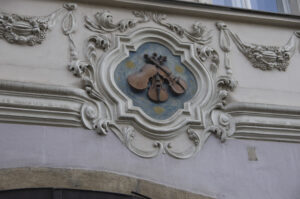Why your house has a number
Numbered street addresses are a relatively recent development, dating largely from the mid-18th century.
Nerudova Street, located in Prague (Czech Republic), still shows how a stranger used to find a person’s home. Each house had a special symbol and a corresponding name.
“You’re looking for Thomas, the fiddle-maker? Why, Thomas lives at the House of the Three Fiddles, of course.” So you would wander up the street, looking at the various emblems built into the wall just above the door of each house. Eventually, you would find the wall showing the three fiddles. And there would be Thomas.
This was all very quaint, made each house unique, and served as an ice-breaker when you finally found Thomas (“ask Thomas about fiddles”, the emblem suggested). But it might have taken a little longer to find Thomas’ house.
Empress Maria Theresa did not particularly appreciate the quaintness of this naming custom. She wanted her government officials (for example, tax collectors) to find addresses more quickly. In 1770, she required that each house have a unique number rather than just a unique doorway emblem. Alas! The House of the Three Fiddles – the residence of Thomas Edlinger, the third generation in a long line of fiddle-makers — became plain old “12 Nerudova Street”. It is now a restaurant. One would hope that it might have live entertainment, and perhaps at least one fiddler every now and then?
As tourists prefer emblems rather than numbers, Prague protects the emblems that still survive on Nerudova Street. Those emblems share space with the house numbers required by Maria Theresa (as well as a second orientation numbering system that was introduced at a later time – more numbers).
That is why your house has a number rather than a quaint name and unique emblem telling strangers a little bit about you.


